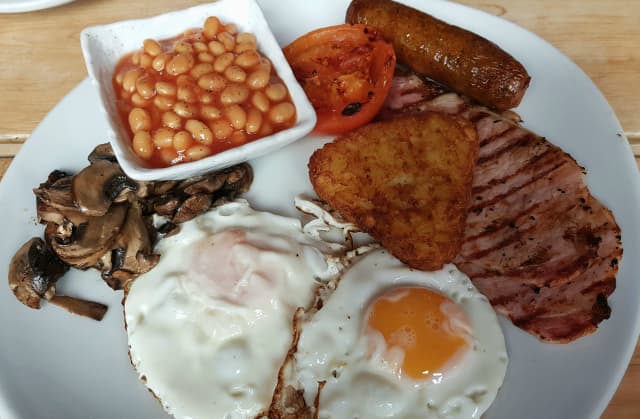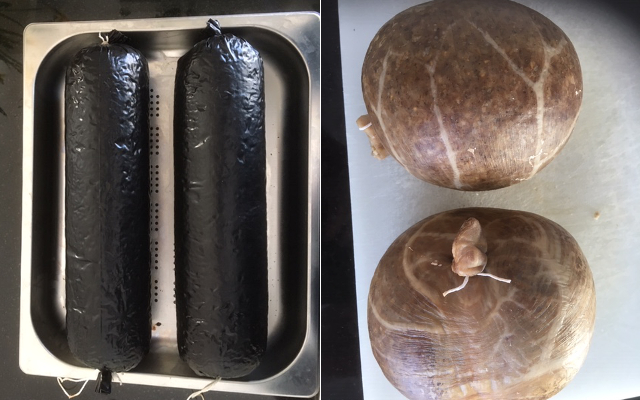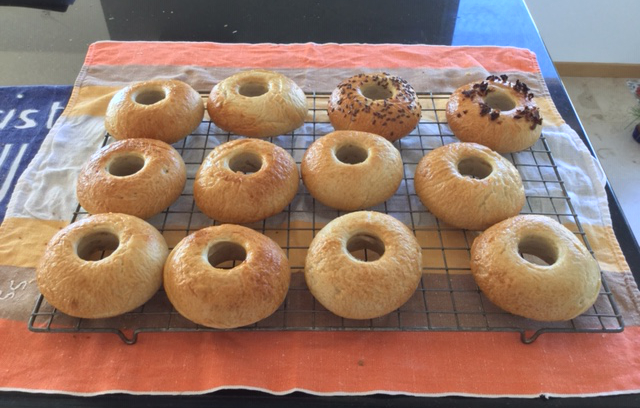How we brought a slice of British cooking to our Swedish home

The Local's Member Terry Clark shares how he and his wife managed to serve up traditional British dinners in Sweden.
When I read Paul Connolly's piece about his experiences of local dishes in Northern Sweden it triggered memories of my experiences of Swedish food down here in Skåne.
My German wife and I have lived here full time now for 15 years and, being tended toward "foodism", we have tried most local delicacies. Some we enjoyed (warm smoked salmon, romsås and färskpotatis), some not (lutfisk).
However, my thoughts were drawn towards the trials we have had to find typical British foods for the odd treat containing a taste of home. We found that some are just not available – not even substitutes for them – here in Sweden.
In the early days we were travelling home quite regularly via the Esbjerg-Harwich ferry and the return trip always included a stop at Waitrose in Bishops Stortford or Morrison's in Parkstone to stock up with Branson, Tea, spam, suet, sausages, black pudding et cetera. Sadly when this route closed the long overland trip added the problem of keeping fresh items cool until we could freeze them. It proved difficult to buy frozen food and keep that frozen too.
READ ALSO: 'Sweden ticks all the boxes, except for one: the food'
Our next supply option was to use one of the British shops in Sweden and on the internet but sadly it did not prove to be too successful. Apart from the much higher base price for basic British products, here or online, we found that every shopping list had at least one item "out of stock", so to complete the order we had to pay extra cost for the freight on two orders and this made the process of questionable value. It would perhaps be worth the extra for some real treat, but for a tin of spam or a jar of Branson pickle – I don't think so. By the way, picnicbog is a good spam substitute and homemade pickle is just as good.
Anyhow, already having some dietary restrictions (being diabetic), I found that at lot of ordinary Swedish food was too high in sugar or just plain sweet – even bread was too sweet!
To overcome this sweetness in "normal" food, my new hobby emerged – I started to bake my own bread. This allowed me to have more control over what ingredients went into it.
READ ALSO: The word that epitomizes Swedish food
Now we rarely eat shop bought bread any more – just the occasional fresh baked roll for breakfast or a plain loaf for toast. I did start baking rolls and crusty loaves, which made great bacon rolls and toast, but the effort was not justified for the odd bacon sandwich when shop-bought was ok.
I bake a sourdough loaf crammed with seeds or walnuts, onions, fennel seeds and crushed wholemeal wheat. All are baked in batches, sliced and frozen in small packs.
This hobby has expanded now to fill gaps in the different foods we miss – those that just cannot be sourced here. The penchant for sweet things in Swedish cooking (even savoury dishes) was the main driver for this, but also the different choices in seasonings, herbs, spices and pungency.

Black pudding and haggis. Photo: Terry Clark
It started in earnest one Christmas when we decided it would be a traditional English Christmas (we rotate between English, German and Swedish) and that meant turkey, stuffing, mince pies and sausage rolls. So we needed to get mincemeat for the mince pies and sausagemeat for the sausage rolls and forcemeat stuffing.
Due to strict kitchen demarcation – my department is designated as the meaty (and savoury) while my wife's is sweet things (and anything that needs to be manipulated with a rolling pin) – she made mincemeat and let it mature for a several weeks in readiness for baking at Christmas.
I started testing mixtures to get a suitably herbed sausagemeat filling with the right texture for sausage rolls. Eventually my trusty Electrolux Assistant (with mincer attachment) oozed out a speckled pinkish mixture that looked and felt right.
It all worked out well with the mince pies too. After letting the mixture stand for weeks my rolling-pin-wielding wife made them using her own homemade pastry. I'm limited to eating one or two only though. As a special treat we made ourselves a Tunis cake which is no longer commercially available. As a diabetic I'm ok with this as the chocolate is high cocoa, low sugar.
When it came to my job on the sausage rolls I used shop bought puff pastry, and the result was really excellent and enjoyed by all.
So, flushed with success, I wondered if the same mixture could be used to make sausages, scotch eggs (baked, not deep fried) for summer picnics, ploughman's lunches et cetera. Answer: yes and no.
READ ALSO: The Local's favourite Swedish recipes

Homemade bagels. Photo: Terry Clark
The fun began when I started trying to make sausages using the new sausagemeat recipe. First off I had to find casings, which we wanted to be natural. Then the wrestling with the long snake slivering out of the spout on the Electrolux was rather challenging. I learned then that the sausagemeat for normal sausages needs to be a different texture to that for sausage rolls, so although tasty I was unhappy with the firm texture of final product.
Other local products such as pickled gherkins are also quite sweet here so I made salt gherkins although we both love the Swedish pressgurka.
There were a couple of things I thought would be too difficult: bagels, pork pies, pie and mash type pies and black pudding (in Sweden blodpudding contains raisins and cinnamon).
Over the years these have been tackled and now our special treat is a full English cooked breakfast with homemade black pudding and sausages. We have homemade bagels with cream cheese and smoked salmon on high days and holidays and I can relive my schooldays with pie, mash and liquor. Pork pies are now a staple for summer lunches with a nice salad.
The one thing that I thought would always evade me, mainly because of the odd ingredients, was haggis. But after a lot of research and substitutions we cracked that as well, including the animal stomach casing.
One area where the sweet/savoury demarcation breaks down is brioche – that has been designated as savoury, as have teacakes/hot cross buns. We do like semlor though.
Finally, leaping to the defence of Swedish specialities – Västerbotten pie is ambrosia to me. Naturally we make our own version heavily laden with Västerbotten cheese (in fact there are two in the freezer right now).
READ ALSO: How to make Swedish Västerbotten pie
Do you want to contribute to The Local? Read more about getting involved here.
Comments
See Also
When I read Paul Connolly's piece about his experiences of local dishes in Northern Sweden it triggered memories of my experiences of Swedish food down here in Skåne.
My German wife and I have lived here full time now for 15 years and, being tended toward "foodism", we have tried most local delicacies. Some we enjoyed (warm smoked salmon, romsås and färskpotatis), some not (lutfisk).
However, my thoughts were drawn towards the trials we have had to find typical British foods for the odd treat containing a taste of home. We found that some are just not available – not even substitutes for them – here in Sweden.
In the early days we were travelling home quite regularly via the Esbjerg-Harwich ferry and the return trip always included a stop at Waitrose in Bishops Stortford or Morrison's in Parkstone to stock up with Branson, Tea, spam, suet, sausages, black pudding et cetera. Sadly when this route closed the long overland trip added the problem of keeping fresh items cool until we could freeze them. It proved difficult to buy frozen food and keep that frozen too.
READ ALSO: 'Sweden ticks all the boxes, except for one: the food'
Our next supply option was to use one of the British shops in Sweden and on the internet but sadly it did not prove to be too successful. Apart from the much higher base price for basic British products, here or online, we found that every shopping list had at least one item "out of stock", so to complete the order we had to pay extra cost for the freight on two orders and this made the process of questionable value. It would perhaps be worth the extra for some real treat, but for a tin of spam or a jar of Branson pickle – I don't think so. By the way, picnicbog is a good spam substitute and homemade pickle is just as good.
Anyhow, already having some dietary restrictions (being diabetic), I found that at lot of ordinary Swedish food was too high in sugar or just plain sweet – even bread was too sweet!
To overcome this sweetness in "normal" food, my new hobby emerged – I started to bake my own bread. This allowed me to have more control over what ingredients went into it.
READ ALSO: The word that epitomizes Swedish food
Now we rarely eat shop bought bread any more – just the occasional fresh baked roll for breakfast or a plain loaf for toast. I did start baking rolls and crusty loaves, which made great bacon rolls and toast, but the effort was not justified for the odd bacon sandwich when shop-bought was ok.
I bake a sourdough loaf crammed with seeds or walnuts, onions, fennel seeds and crushed wholemeal wheat. All are baked in batches, sliced and frozen in small packs.
This hobby has expanded now to fill gaps in the different foods we miss – those that just cannot be sourced here. The penchant for sweet things in Swedish cooking (even savoury dishes) was the main driver for this, but also the different choices in seasonings, herbs, spices and pungency.

Black pudding and haggis. Photo: Terry Clark
It started in earnest one Christmas when we decided it would be a traditional English Christmas (we rotate between English, German and Swedish) and that meant turkey, stuffing, mince pies and sausage rolls. So we needed to get mincemeat for the mince pies and sausagemeat for the sausage rolls and forcemeat stuffing.
Due to strict kitchen demarcation – my department is designated as the meaty (and savoury) while my wife's is sweet things (and anything that needs to be manipulated with a rolling pin) – she made mincemeat and let it mature for a several weeks in readiness for baking at Christmas.
I started testing mixtures to get a suitably herbed sausagemeat filling with the right texture for sausage rolls. Eventually my trusty Electrolux Assistant (with mincer attachment) oozed out a speckled pinkish mixture that looked and felt right.
It all worked out well with the mince pies too. After letting the mixture stand for weeks my rolling-pin-wielding wife made them using her own homemade pastry. I'm limited to eating one or two only though. As a special treat we made ourselves a Tunis cake which is no longer commercially available. As a diabetic I'm ok with this as the chocolate is high cocoa, low sugar.
When it came to my job on the sausage rolls I used shop bought puff pastry, and the result was really excellent and enjoyed by all.
So, flushed with success, I wondered if the same mixture could be used to make sausages, scotch eggs (baked, not deep fried) for summer picnics, ploughman's lunches et cetera. Answer: yes and no.
READ ALSO: The Local's favourite Swedish recipes

Homemade bagels. Photo: Terry Clark
The fun began when I started trying to make sausages using the new sausagemeat recipe. First off I had to find casings, which we wanted to be natural. Then the wrestling with the long snake slivering out of the spout on the Electrolux was rather challenging. I learned then that the sausagemeat for normal sausages needs to be a different texture to that for sausage rolls, so although tasty I was unhappy with the firm texture of final product.
Other local products such as pickled gherkins are also quite sweet here so I made salt gherkins although we both love the Swedish pressgurka.
There were a couple of things I thought would be too difficult: bagels, pork pies, pie and mash type pies and black pudding (in Sweden blodpudding contains raisins and cinnamon).
Over the years these have been tackled and now our special treat is a full English cooked breakfast with homemade black pudding and sausages. We have homemade bagels with cream cheese and smoked salmon on high days and holidays and I can relive my schooldays with pie, mash and liquor. Pork pies are now a staple for summer lunches with a nice salad.
The one thing that I thought would always evade me, mainly because of the odd ingredients, was haggis. But after a lot of research and substitutions we cracked that as well, including the animal stomach casing.
One area where the sweet/savoury demarcation breaks down is brioche – that has been designated as savoury, as have teacakes/hot cross buns. We do like semlor though.
Finally, leaping to the defence of Swedish specialities – Västerbotten pie is ambrosia to me. Naturally we make our own version heavily laden with Västerbotten cheese (in fact there are two in the freezer right now).
READ ALSO: How to make Swedish Västerbotten pie
Do you want to contribute to The Local? Read more about getting involved here.

Join the conversation in our comments section below. Share your own views and experience and if you have a question or suggestion for our journalists then email us at [email protected].
Please keep comments civil, constructive and on topic – and make sure to read our terms of use before getting involved.
Please log in here to leave a comment.